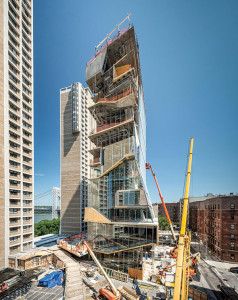Leslie E. Robertson Associates was an Outstanding Award Winner for the Columbia University Medical Center Graduate Education Building project in the 2015 NCSEA Annual Excellence in Structural Engineering awards program (Category – New Buildings $30M to $100M).
The Columbia University Medical and Graduate Education Building (CUMGEB) is a 100,000 square-foot, 15-story, state-of-the-art medical education facility, whose multifaceted goals include the linking of students and teachers, of interdisciplinary study and interactive learning, and of function and experience, all while providing an identity and focal point for Columbia University’s Washington Heights campus. CUMGEB aspires to be an iconic facility for the university and neighborhood, helping to attract the world’s top medical students. The design team included Diller Scofidio + Renfro (DS+R) in collaboration with executive architect Gensler. Leslie E. Robertson Associates (LERA) provided structural engineering services. F.J. Sciame Construction is the project’s construction manager.
The project’s main feature is a southern facing “Study Cascade” that contains interconnected study and social spaces to encourage collaboration between students. The study cascade is envisioned as a vertical campus of stacked “neighborhoods”, which are two to three story, near atrium-like clusters of diversified social spaces. The southern campus-facing façade is a highly articulated all-glass system that is crucial to the building’s expression. The northern half of the building is organized for classrooms and administrative space, in addition to a mid-tower mechanical space to accommodate the needs of the building’s Anatomy Labs.
CUMGEB’s main structural design challenge was to find vertical load paths through the Study Cascade while respecting the varied spatial planning of the stacked neighborhoods. To minimize the structure’s impact on these spaces, the cascade floors are supported by a pair of inclined composite concrete columns that are architecturally exposed and cast with high strength (10 ksi), self-consolidating concrete. These two exposed columns slope from the foundation level up to the 8th floor in order to direct loads around a column-free auditorium at the base of the Cascade. The thrusts that result from the changes in direction of the sloping columns are resisted by in-floor trusses constructed with post-tensioning and high-strength rebar.
An additional structural challenge was to provide long, open floor spans with minimal structural depth that could simultaneously accommodate the tight deflection performance requirements of the all-glass façade. The cascade structure has no perimeter columns, which results in a unique sequence of cantilevered concrete flat slabs. To meet the slab performance requirements, the cantilevered slabs are reinforced with a bonded post-tensioning system. Void formers, manufactured by Cobiax USA, are placed between bands of post-tensioning to create long-span, beam-like framing with flat formwork and to reduce the structure’s self-weight. The cantilevered slabs utilize high strength concrete (8 ksi) and taper in thicknesses from 24 inches at supports to 8 inches at the cantilever tips.
The curtain wall of the cascade is arranged in multi-story planes that do not align in plan between neighborhoods and are not parallel with the slab’s edges, creating detailing challenges for both the structure and façade. Through a design assist phase, expected deflections from slab curvature were coordinated at each glass mullion with the curtain wall contractor, Gartner, and together the project team decided on an acceptable long-term deflection limit of 1¼ inches for cantilevers up to 26 feet. The bonded post-tensioned slabs were tuned to meet these performance requirements and were detailed to accommodate a range of façade attachment methods.
The building’s structural design achieves efficiency by embracing the building’s stacked neighborhoods. The structural system of the cascade leverages the natural interconnections that come from the unique arrangement of the program spaces of the vertical campus. Single story walls and ramps connect and stiffen the cantilevered slabs, allowing for material savings in the slabs.
Long-term column shortening of the two Cascade columns causes amplified deflections at the tips of the cantilevers they support. To account for this phenomenon, a staged construction analysis was performed and summarized into a simple planar cambering schedule for the Cascade slabs. Super-elevated slab positions were determined to help assure that the slabs would be level after long-term column shortening occurs. Curtain wall installation procedures are intended to account for the slabs’ super-elevated positions.
Although the project is relatively small in area, CUMGEB is a complex building with broad aspirations. The design and construction challenges of CUMGEB are similar to those often found in much taller buildings and longer-span structures. The goals of the project were achieved through the successful use of proven construction technologies, extensive analysis and coordination, and a strong integration of architecture and structure.▪

